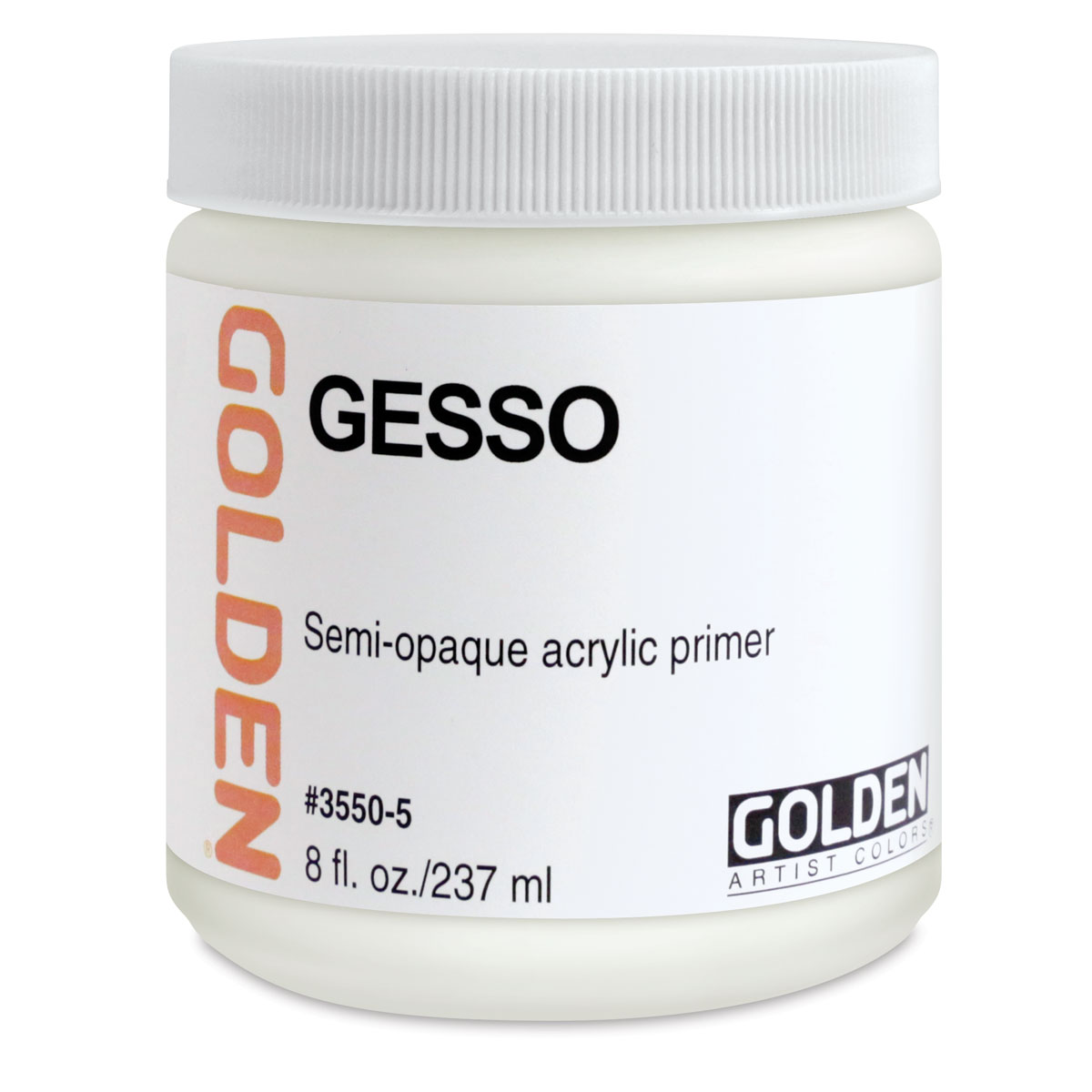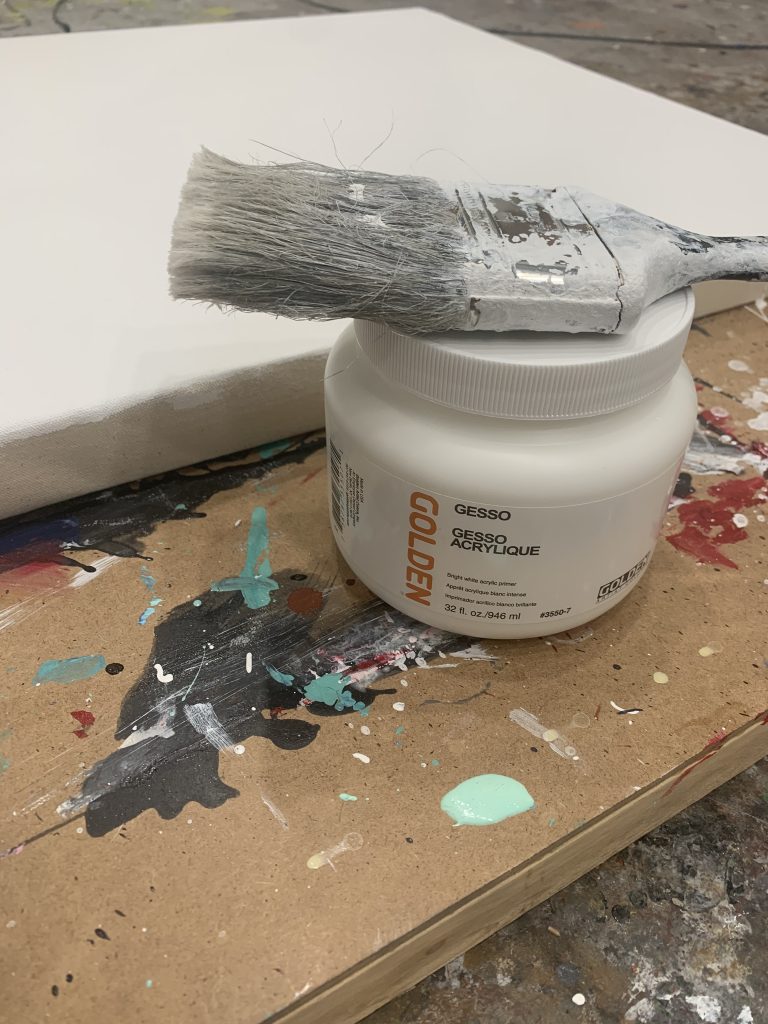If you are painting with acrylic paint, it is important to prime the canvas before you begin painting. Let’s face it, paint is expensive. By Priming the canvas with a high quality gesso, you can get the most out of your expensive colors. Not only that, priming the canvas helps to make your painting last longer and look better.

Golden Acrylic Gesso – $19.24
from: Blick Art Materials
Why should I prime a canvas With gesso?
Priming a canvas creates a better bond between the actual acrylic paint and the weave of the canvas. When we are talking about working with acrylic paints, the best primer to use is an acrylic gesso. Gesso is designed to soak into the weave of the canvas and seal it. The means that your actual colored paint will sit on top of the canvas rather than soak in and look muted. It also has a fair amount of chalk in it. The chalk creates a “tooth” that helps the paint to adhere to the canvas. This tooth means that the paint on the surface will stick to the canvas better, and will help it to avoid cracking and delaminating from the canvas as time goes on.

What is The difference between sizing and priming?
Sizing is used more often in oil painting. By its very nature, oil paint can rot the canvas over time. By sizing the canvas, a very thin layer of a sealant soaks into the canvas fibers and protects them from the oil paint. If you are working with oil, I would recommend using Gamblin PVA Size as the first layer on your raw canvas. Traditionally oil painters have used rabbit skin glue as a size, and more recently acrylic dispersion products as a size.
Now if you are using acrylic paint, then sizing is less of an issue because acrylic paint doesn’t rot canvas in the same way that oil paint does. There are some cases where you may still want to consider using a sizing on an acrylic painting. This is when you might run into issues with support induced discoloration from the surface you are working on.
What is Support Induced Discoloration?
Support induced discoloration occurs when tiny impurities from the surface (canvas, panel, or whatever you are painting on) are sucked up into the paint as it dries. These impurities can cause a yellowing of the paint as it dries.
Do I need to size a canvas If I am painting with acrylic paint?
Generally no, and this is because most acrylic gessos do a fair bit of sizing on their own. They do this by soaking into the canvas an sealing it. One time where you would want to size the canvas are if you are working with a lot of translucent colors. Translucent colors show support induced discoloration more readily. If you are using more opaque paint, the pigments in the paint will usually hide any kind of support induced discoloration. Another time that you may want to consider sizing is if you are working on a type of surface that would contain a lot of impurities like some types of wood.
Golden Gloss Medium is generally recommended as a suitable size for working under acrylic paint.
Can I paint on raw canvas?
Yes you definitely can, and many artists throughout history like Morris Louis and Helen Frankenthaler have worked by staining the paint directly into the canvas. This creates a unique effect that is almost like water color paint. There are issues down the road for conserving these paintings, as the canvas fibers are open to the atmosphere, dirt, and moisture. (Morris Louis paintings actually need to be vacuumed!)
If you want to benefits of acrylic gesso, but still want to see the color and weave of the canvas. You can use a product like Golden Matte Medium. The matte medium provides a clear layer of protection to the canvas and still has enough tooth for subsequent paint layers to adhere to.
What is the best primer for an acrylic painting?
For most acrylic paintings on canvas, an acrylic gesso will provide the best surface to paint on. There are many different brands and qualities of acrylic gesso and I will examine some of the best ones a little later in the article. They usually come in white which is a great choice for gesso. Part of the luminosity of a painting comes from light being reflected back to your eyes through the paint. So a white surface is going to be the most reflective and the most luminous. Titanium white, the main pigment in most gessos also has a very high covering power which is an added benefit.
Can’t I just use white paint as a primer?
Gesso is not only a mixture of acrylic medium and white pigment. There is also usually a component that helps to make it absorbent and add a tooth for adhesion. This is usually calcium carbonate or chalk. It is also designed to be brushed onto raw canvas easily and soak in, so it is usually a little thinner then regular paint. It is designed to shrink a bit as it dries in order to help tighten the canvas on the stretcher bars. So if you were to use white paint alone, not only would it more expensive, but you would be missing out on the ease of application, shrinking factor, and adhesion properties of a true acrylic gesso.
Can I use a colored primer for an acrylic painting?
Well there aren’t that many brands that specifically make a colored gesso, there are some alternatives that work quite well. One that I have used is Golden High Load Acrylics. They are like normal golden acrylics but have a super high load of pigment in them. The higher ratio of pigments actually makes them more “toothy” so they behave a lot like gesso on the canvas. I have used them in a past when I wanted a rich warm earth tone background. I achieved this by mixing the yellow ocher and burnt sienna Golden High Load Acrylics with a bit of white gesso.
How do you apply acrylic gesso to a canvas?
It is actually very easy to apply. In general, you want to apply 2 to 4 coats of acrylic gesso for maximum protection and adhesion. The amount of coats you will need will depend heavily on how high a quality your gesso it. It is best to apply several thin coats, then one thick coat. Gesso isnt quite as flexible as regular acrylic paint because of the water and chalk content. So thin coats can avoid the gesso cracking down the line if you are working on a flexible surface like canvas.

STEP 1
Lay your canvas flat on the ground face up. Some people like to run a pumice stone lightly over the canvas to remove any irregular bumps, but this is not necessary.
STEP 2
Dip a 2 to 3″ stiff brush into the gesso container and begin applying it using a scrubbing motion from one side to another. The scrubbing allows you to just apply as much as is necessary, get in between all of the fibers, and avoid brush marks caused by applying it to thick.
STEP 3
Wait until the surface is touch dry and repeat. It usually takes about an hour for it to be dry. You don’t want to apply it to soon because it might pull up the previous layer.
STEP 4
Let dry thoroughly and your canvas is ready to paint on. I like to leave the canvas overnight before I work on it, but if it is dry to the touch you could start painting on it right away. If you are going to be drawing on it with a pencil, make sure that it is quite dry to avoid pulling at the gesso. Also, if you are planning on painting on top of it with oil paint, you should wait much longer to ensure that the water has fully evaporated before you start painting.
What Is The best White Acrylic Gesso?
Almost every brand that makes acrylic paint makes an acrylic gesso. It is a good idea to stick with the same brand as the paint you are using because then you know that they are designed to work together. Having said that, most types of acrylic gesso contain essentially the same basic ingredients
The best acrylic gesso: Golden Gesso

Golden Acrylic Gesso – $19.24
from: Blick Art Materials
This acrylic gesso comes in both white and black. It goes onto raw canvas very easily and provides excellent adhesion, tooth, and shrinkage. I have used this gesso almost exclusively for the last 15 years it is that good. One of the biggest benefits of Golden Gesso is it’s covering power. In fact, I often only need 2 thin coats of gesso to have a solid what base for my painting. You will really notice how loaded with pigment it is when you go to wash your brush and white paint just KEEPS COMING OUT. Amazing product.

Let me know in the comments if you have any more questions about how to apply acrylic gesso.


